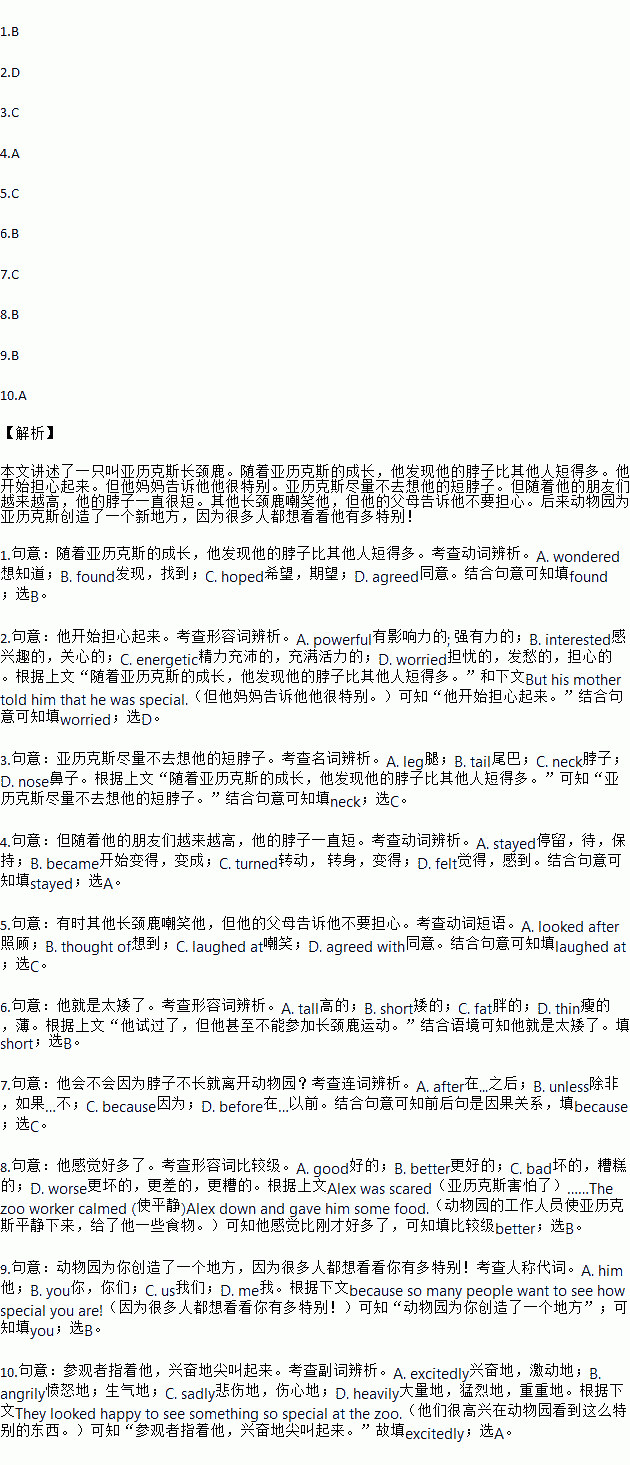题目内容
Alex was a giraffe who lived in a zoo with his mum, dad and other giraffe friends. As Alex grew, he ______ his neck was much shorter than the others’. He began to get______. But his mother told him that he was special. She said it did not matter how short or long his neck was.
Alex tried not to think about his short ______. But as his friends grew taller and taller, his neck ____ short. Sometimes the other giraffes ______ him, but his parents told him not to worry. They said that he should be happy with himself the way he was. He tried, but he could not even play in some giraffe sports. He was just too ______.
One day, one of the zoo workers came and took Alex away. Alex was scared. Would he have to leave the zoo just ______ he didn't have a long neck? The zoo worker calmed (使平静)Alex down and gave him some food. He felt _______Then he led Alex into another area of the zoo.
Soon mum and dad came to see Alex. “I told you that you were special,” his mother said. “The zoo has made a place just for ______ because so many people want to see how special you are!” She was right. Visitors pointed to him and screamed(尖叫)______. They looked happy to see something so special at the zoo.
1.A. wondered B. found C. hoped D. agreed
2.A. powerful B. interested C. energetic D. worried
3.A. leg B. tail C. neck D. nose
4.A. stayed B. became C. turned D. felt
5.A. looked after B. thought of C. laughed at D. agreed with
6.A. tall B. short C. fat D. thin
7.A. after B. unless C. because D. before
8.A. good B. better C. bad D. worse
9.A. him B. you C. us D. me
10.A. excitedly B. angrily C. sadly D. heavily
 阅读快车系列答案
阅读快车系列答案阅读填空 先通读下面的短文,然后根据短文内容,在文章后表格的空格内填入一个最恰当的单词。所填单词必须写在答题卡对应题号的横线上。每个空格只能填一个单词。
Getting electricity has always been a problem for the 173 people living in Nuevo Saposoa, a small village in Peru, South America. However, things went worse in March 2017 after heavy rains damaged the only power cables(电缆) in the area. The villagers were forced to use oil lamps, which are not only expensive but also dangerous because of the harmful gases they produce.
Luckily, researchers at the University of Technology (UT) in Lima, Peru heard about their problem and found a wonderful method to solve it. They made a lamp that can be powered by plants and soil, both of which can be easily found in the Amazonian rainforest where the village lies. The lamp takes energy from a plant growing in a wooden box and uses it to light up an LED light bulb.
While that may sound amazing and even impossible, the science behind the idea is quite simple. As plants create their food (using the sun’s energy, water and chemicals from the soil), they also produce waste which they return to the soil. Tiny animals in the soil eat this waste and they produce electrons(电子). The UT team put special sticks inside the soil to get the energy and keep it in the lamp’s batteries for later use. The researchers say a single charge(电荷) can power a 50-walt LED light for two hours-enough time for local villagers to get their evening work done.
The university gave ten Plant Lamps to the villagers of Nuevo Saposoa in October 2017. So far, they have been a huge success! Elmer Ramirez, the UT professor who invented the lamp, believes the Plant Lamp could help improve the lives of many people, especially small rainforest communities, 42% of whom have no electricity.
Topic: A new invention-the Plant Lamp | |
The problem in the small village | The people living in Nuevo Saposoa have much 1. getting electricity. However, things went worse for the only power cables there were destroyed by heavy rains. The villages had to use oil lamps, although they are expensive to use and can be bad for people’s health. |
The method to solve the problem | ★Some researchers made a new kind of lamp. It can be powered by2. objects found in the rainforest-plants and soil. ★The lamp takes energy from a plant growing in a wooden box and uses it to light up an LED light bulb. |
The science explanation | ★Plants create their food and produce waste which is3. to the soil at the same time. Some tidy animals feed on the waste and produce electrons. ★The UT team can get the energy and keep it in the lamp’s batteries. A 50-walt LED light can be powered by a single charge for local villagers to4. their evening work. |
Conclusion | Ten Plant Lamps were given to the villagers in October 2017 and they have been very5. since then. Elmer Ramirez, the inventor of the lamp, believes that they could be the most helpful for the small rainforest communities. |

